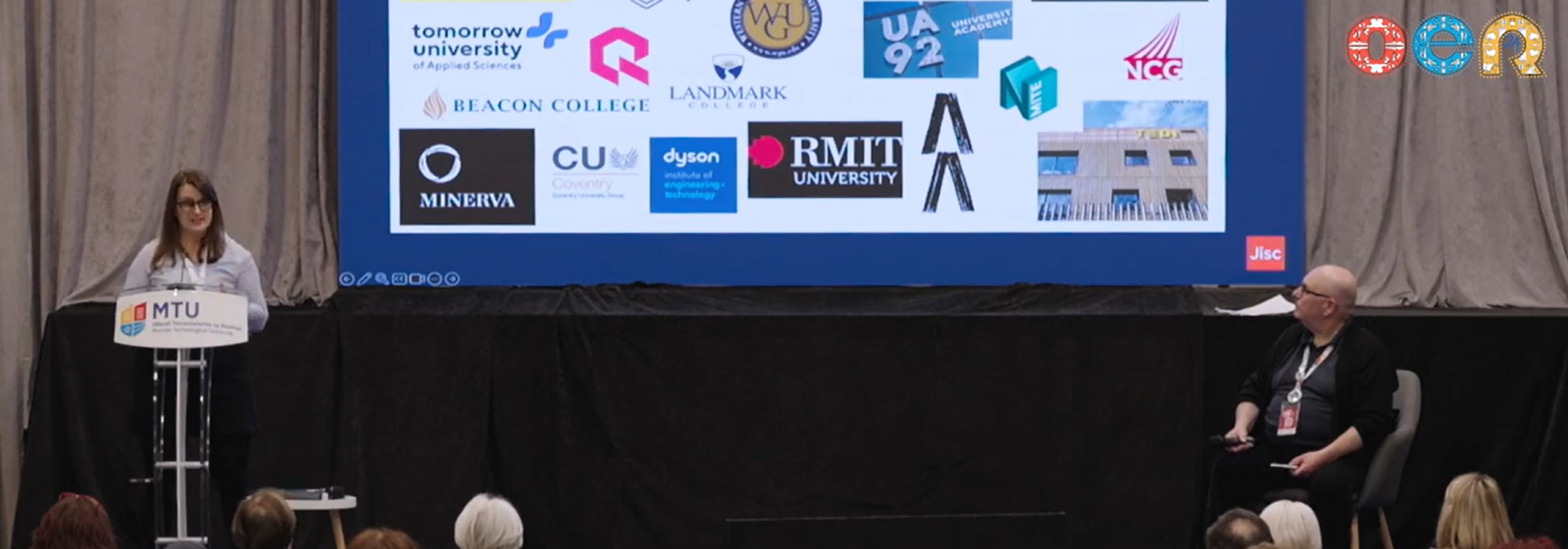An #OER24 Gasta, expanded.
A guest post from Emma Beatson, Jisc
The world is in crisis. Countless issues intersect and conflict. Many current systems aren’t fit for purpose and new solutions are required. Technology can be leveraged for transformation. Innovation is forcing change and education is not immune.
New models of higher and further education are emerging. Globally, educational institutions with alternative missions and methods of operation and delivery are establishing and expanding. They are reacting to markets, disrupting traditional ideas of universities and colleges, and changing the student experience and how staff work and behave.
I think it is important to ask whether these new ways of operating present an opportunity or threat for Open education. But I will not attempt to answer that question, nor do I have opinions to share. I just hope that if you, reader, feel it is important too, then you will consider the answer.
Some project background
I became focused on understanding new and emerging models in tertiary education in late summer 2022. In the beginning, I simply researched the new trends, identifying institutions that seemed to be doing things a bit differently. I started referring to these as “challenger” or “disruptor” institutions.
But then I became very interested in what was driving these trends into existence. What were the social, environmental, economic, technological drivers of change – domestic and global? What could happen to encourage and further embed them in the future? These trend drivers dominated the project work. With the help of the Jisc Innovation team, a huge amount of information was gathered. To help organise it, it was grouped into six themes:
- Changing global demand and access to education.
- Needs of business and industry.
- Climate and environment.
- Student viewpoints.
- Social justice
- Emerging technology.
We hoped that our findings about drivers of change would be useful to educators considering futureproofing. The volume of issues to consider is enormous, and we wanted to make that load more manageable. We aimed to consolidate all the information, provide a (friendly) heads-up about the possible implications for education, and to help institutions to identify the opportunities.
So, we created a workshop.
The Imagined Futures workshop
The Imagined Futures workshop is based around challenge cards, depicting mini scenarios of things that could happen in the future. These include a mix of things that are already emerging, some that are strongly predicted to occur, and some that are a little more leftfield, but still entirely possible. They are organised into the six themes mentioned above, and while we call them ‘challenges’, they are not designed to be dystopian or negative. We have over 100 challenges and they include things like this:
- A large percentage of under 18s consider themselves to be neurodivergent.
- Traditional teaching tools like screens and whiteboards have been completely replaced by virtual reality and hologram teachers.
- Average life expectancy across the world has jumped significantly and the number of people aged 80 or above has tripled. But in Africa, rapid population growth has led to a ‘youthquake’ and over 50% of the population is under 25.
- Institutions become accountable for the carbon cost of their learners.
- A data protection act bans all use of student data for analytics and surveillance.
Workshop participants get a chance to think about how they could react to and prepare for some of the challenges (either thinking about the institution they work in or a ‘dummy’ one we supply an idea for). They then go onto imagine a future institution that has embraced those challenges.
Are the disruptor institutions leading the way forward?
It is worth noting that in the Imagined Futures workshop we don’t present any of the emerging trends to the participants, or details of the disruptor institutions we identified. We discuss the challenges from our findings about the drivers only.
We’ve had over 750 people interact with these workshop resources since summer 2023, and a wealth of ideas for futureproofing have been generated.
But what we found was that the imagined futures the participants had about the institutions, were largely, if not completely models that are already being implemented by our identified disruptor institutions. I don’t say this critically – I think it means there is consensus and a clear way forward for educators. But I do think it means we must take notice of these disruptors and what it is they are doing.
The trend and the disruptor institutions
We’ve identified around 30 characteristics or models of alternative ways of working delivered by the disruptor institutions we identified. Some of the institutions do a lot of these things, some just a few, or even one. But there is one overarching characteristic that appears to be true across almost all of them – they embrace the student as a consumer.
I have ordered the rest of the characteristics into four groups. These are:
Group 1 – Mission open
The disruptor institutions implementing these models seem to be doing their very best to make education as accessible as possible to students who have additional barriers to entry. Their offerings include:
- Fees based on circumstance.
- Tuition-free study.
- Equitable access.
- Alternative admissions.
- Ethical internationalisation.
- Tailoring for neurodivergence.
Group 2 – Practical access
The disruptor institutions doing these things are also making themselves more easily accessible – but less through guiding mission and more via operational model changes that give students flexibility in time, cost and how they pay for and access their learning, via models such as:
- Unbundled services.
- Low-fees and no-frills.
- Alternative payment structures and methods.
- Lifelong, stackable and flexible credentials.
- Loss of academic calendar and alternative timetabling.
- Non-standard pacing.
- CX focus – 24/7 support and one-to-one mentors.
- Mobile-first delivery.
- Global delivery.
Group 3 – Employment priority
Many of the disruptor institutions embrace the purpose of education as a route to employment, and their models help to prioritise the employability of students and graduates, including:
- Competency-focused education.
- Multi-disciplinary curriculum.
- Phenomenon-based learning.
- Applied learning and real-world project experience.
- Subject-specialist mission.
- Industry co-creating and delivering curriculum.
- Industry accredited to deliver courses.
- Blending of FE and HE.
- Local partnerships between academia and SMEs.
Group 4 – Efficiency meets altruism
The characteristics displayed in this group are changes to organisational structure designed to maximise efficiencies or (but usually ‘and’) increase the positive impact the institution is having on their students and the world around them:
- Academic alliances.
- Place-based collaboration.
- Civic aims.
- Staff-student collaboration and co-creation.
- Ethical specialism and mission.
- City as campus.
- Campus as city.
So, Open education opportunity or threat?
On the face of it, the characteristics on the lists above seem to be good stuff, designed to improve the lives of those who study and work within those institutions.
But we can’t ignore the fact that many of the pioneering disruptor institutions driving these models forward are private, profit-driven entities. To be clear, I’m not claiming that these new models of operation are solely emerging in private institutions. Indeed, we’ve found long-established and non-profit institutions innovating in line with these characteristics. And some of the disruptors on our list actively prioritise public benefit over profit – but many of them don’t.
So, I ask again, whether these new ways of operating present an opportunity or threat for Open education? Should we be celebrating and emulating these innovative providers, or bracing for a future fight against for-profit models and restricted access from institutions that keep a closer eye on the bottom line than student outcomes?
Let me know what you think, comment below.

